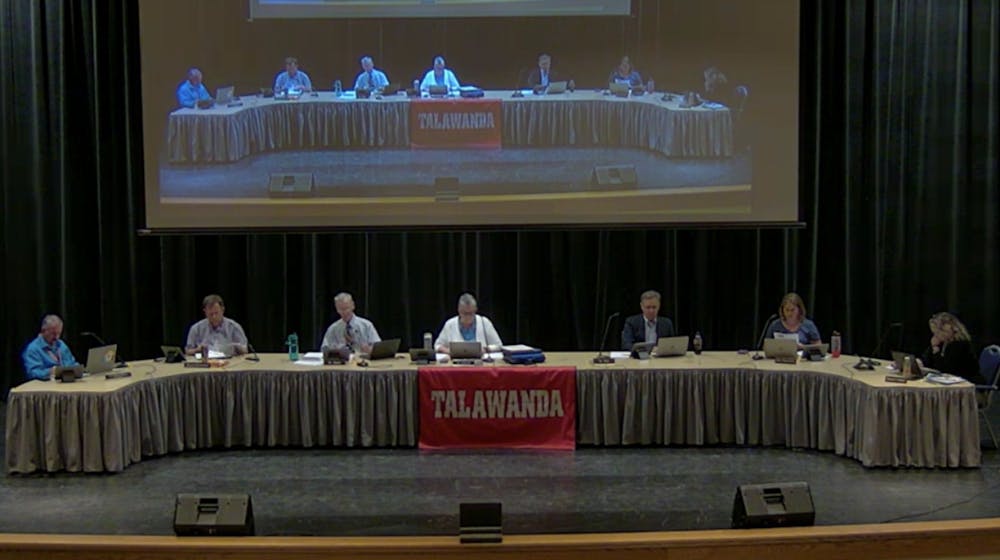The Talawanda School District Board of Education made its final decision on the busing system and school start times for the 2024-2025 school year at its May 16 meeting. The board also presented its five-year forecast and discussed a school breakfast and lunch price increase.
In preparation for the vote on the busing system, the board sent out a survey to the community to get feedback on the issue and to allow families to express support for one of the busing systems: keeping the current one-tier option, changing to a two-tier system requiring start times to be moved up or reverting to a previous system with later start times for elementary students and earlier start times for middle and highschoolers.
The board voted on initiating the one-tier busing system Kindergarten through eighth grade, in addition to special education at Butler Tech. The chosen system will also continue to not provide busing to the high school, in addition to no busing for families living two miles or less from their respective school. The current start and end times for all schools will remain for the 24-25 school year based on the board's financial decision.
During the board’s conversation, School Board President Rebecca Howard voiced her concern that the people most affected by the one-tier busing weren’t represented. Howard said she felt she didn’t receive enough data from the survey to make the decision to change the busing system from what it's currently at.
However, Superintendent Ed Theroux said he believes the responses were adequate enough for a vote.
“[Through emails] we had over 900 respondents,” Theroux said. “I mean, we can only do what we can do, and I don't want my personal opinions to really guide my votes. I want to hear the voices of the people. I mean, that's what representation is all about. And I think that people did respond.”
Howard said another concern she had was the $1 million they would save going from the two-tier system to one-tier. However, when the numbers were run again, it showed only $520,000 in savings. The board agreed that half a million was still a large sum of money.
After a vote, the one-tier busing system was approved for another year.
“I want people to understand none of us are making any of these decisions lightly,” Howard said. “We wrestle with these things. We are members of this community. We have family members, friends, neighbors who are impacted, we live these decisions, we know that and we struggle over these decisions.”
Treasurer Shaunna Tafelski presented the biannual five-year forecast, explaining that its purpose is to engage the community and Board of Education in long term planning and financial discussions.
“When we're taking a look at the forecast it consists of three years worth of historical data for both revenue and expenses, plus what we know to be true in the current fiscal year,” Tafelski said, “And then we add in simulations and inflationary indexes for each category to arrive at future projections.”
A financial forecast graph showed that in fiscal year ‘21 through the projected fiscal year ‘28, the actual and projected revenues are increasing. However, there is projected deficit spending in ‘27 and ‘28. Tafelski said throughout this forecast, the revenue has an annual increase of 1.6%, but at this point in time expenses has had an increase of 5%.
Enjoy what you're reading?
Signup for our newsletter
According to an operating revenue graph, 45% of revenue comes from property taxes, 22% from income taxes, and 26% is from the state through the Ohio Department of Education share per student and in the homestead and rollback reimbursement. Which are property tax rollback payments from the state to school districts.
Medicaid reimbursements, investment income, special education tuition from other school districts and prior year refunds are 7% of the revenue.
Tafelski said it’s important to consider that 75% of children's education is being supported by the community, and 25% is being supported by the state.
As noted by the board, some challenges when it comes to finances that are stagnant throughout the forecast include H.B.33, a fair school funding plan where funding isn’t guaranteed as there are two state biennium budgets that need to be passed. Tafelski said H.B. 126 continues to severely limit the board’s ability to challenge valuation reductions, impacting property values and taxes. Inflationary increases to services, supplies and instructional materials necessary to educate have also been an issue.
At the Thursday night meeting, the board also approved an increase to the school breakfast and lunch prices in order to get ahead of its deficit spending, which is projected to be $98,000 this year within the fund.
“We’re aware of and concerned about the impact of any price increase, especially on middle income families who don't qualify for free or reduced lunch, but who also don't necessarily have a heavy discretionary spending cushion,” Howard said. “So this is a fairly minimal increase … we're not doubling the costs.”
This will bee a 25-cent increase for breakfast- elementary through high school, a 25-cent increase for elementary lunches and a 35-cent increase for middle school and highschool lunches. The board said this only applies to students; adults will be analyzed and have a higher increase. Tafelski said the last increase was two years ago.
“I don't like increasing the prices on this. I really don't,” Tafelski said. “But, this is a self-sufficient department that [doesn’t have] any general fund support at all. So I come with a heavy heart knowing that this is going to affect some families.”
The next school board meeting will be held in the Talawanda High School auditorium on June 20 at 7 p.m. A live stream option is available and can be found here.




